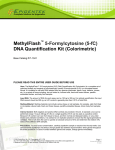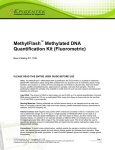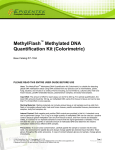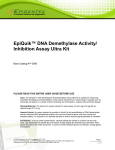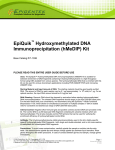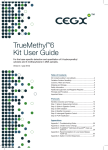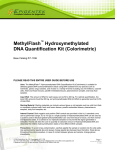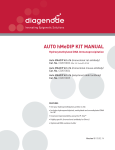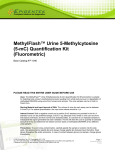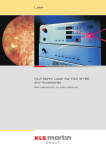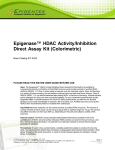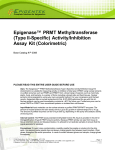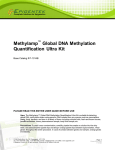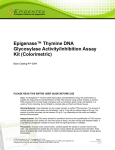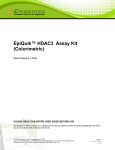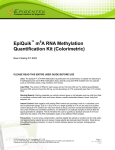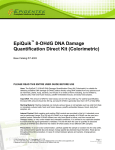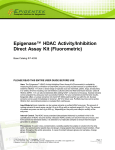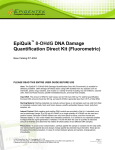Download Epigenase™ 5mC Hydroxylase TET Activity/Inhibition
Transcript
EPIGENTEK Complete Solutions for Epigenetics Epigenase™ 5mC Hydroxylase TET Activity/Inhibition Assay Kit (Colorimetric) Base Catalog # P-3086 PLEASE READ THIS ENTIRE USER GUIDE BEFORE USE Uses: The Epigenase™ 5mC Hydroxylase TET Activity/Inhibition Assay Kit is suitable for measuring the activity/inhibition of total 5mC hydroxylase TET enzyme using nuclear extracts or purified TET isoforms (TET 1-3) from a broad range of species such as mammalian, plant, fungal, and bacterial, in a variety of forms including, but not limited to cultured cells, fresh and frozen tissues. Starting Materials: Input materials can be nuclear extracts or purified TET enzymes. The amount of nuclear extracts for each assay can be 2 µg to 20 µg with an optimal range of 5-10 µg. The amount of purified enzymes can be 20 ng to 1 µg , depending on the purity and catalytic activity of the enzymes. Internal Control: The TET assay standard (5-hydroxymethylcytosine) is provided in this kit for the quantification of TET enzyme activity. Because TET activity can vary from tissue to tissue, and from normal and diseased states, it is advised to run replicate samples to ensure that the signal generated is validated. Precautions: To avoid cross-contamination, carefully pipette the sample or solution into the strip wells. Use aerosol-barrier pipette tips and always change pipette tips between liquid transfers. Wear gloves throughout the entire procedure. In case of contact between gloves and sample, change gloves immediately. 110 Bi County Blvd. Ste. 122, Farmingdale, NY 11735 Tel: 1-877-374-4368 ■ Fax: 1-718-484-3956 ■ E-mail: [email protected] ■ Web: www.epigentek.com © Epigentek Group Inc. All rights reserved. Products are for research use only. Page 1 Printed 2014-09-22 P-3086 EPIGENTEK Complete Solutions for Epigenetics KIT CONTENTS Component 48 Assays Cat. #P-3086-48 96 Assays Cat. #P-3086-96 Storage Upon Receipt WB (10X Wash Buffer) 14 ml 28 ml 4°C TAB (TET Assay Buffer) 3 ml 6 ml RT TS (10 X TET Substrate)* 10 µl 20 µl –20°C BS (Binding Solution) 5 ml 10 ml RT HC5 (TET Assay Standard, 20 µg/ml)* 10 µl 20 µl –20°C HC6 (Capture Antibody, 1000 µg/ml* 4 µl 8 µl 4°C HC7 (Detection Antibody, 400 µg/ml)* 8 µl 16 µl –20°C HC8 (Enhancer Solution)* 8 µl 16 µl –20°C DS (Developer Solution) 5 ml 10 ml 4°C SS (Stop Solution) 3 ml 6 ml RT Co-factor 1* 25 µl 50 µl 4°C Co-factor 2* 25 µl 50 µl 4°C Co-factor 3* 25 µl 50 µl 4°C 8-Well Assay Strips (With Frame) 6 12 4°C User Guide 1 1 RT * For maximum recovery of the products, centrifuge the original vial prior to opening the cap. SHIPPING & STORAGE The kit is shipped in three parts: the first part at ambient room temperature, and the second and third parts on frozen ice packs at 4°C. Upon receipt: (1) Store TS, HC5, HC7, and HC8 at –20°C away from light; (2) Store WB, HC6, DS, Co-factor 1, Co-factor 2, Co-factor 3, and 8-Well Assay Strips at 4°C away from light; (3) Store remaining components (TAB, BS and SS) at room temperature away from light. Note: Check if WB 10X Wash Buffer contains salt precipitates before use. If so, warm at room temperature or 37°C and shake the buffer until the salts are re-dissolved. All components of the kit are stable for 6 months from the date of shipment, when stored properly. MATERIALS REQUIRED BUT NOT SUPPLIED Adjustable pipette or multiple-channel pipette Multiple-channel pipette reservoirs Aerosol resistant pipette tips 110 Bi County Blvd. Ste. 122, Farmingdale, NY 11735 Tel: 1-877-374-4368 ■ Fax: 1-718-484-3956 ■ E-mail: [email protected] ■ Web: www.epigentek.com © Epigentek Group Inc. All rights reserved. Products are for research use only. Page 2 Printed 2014-09-22 P-3086 EPIGENTEK Complete Solutions for Epigenetics Microplate reader capable of reading absorbance at 450 nm 1.5 ml microcentrifuge tubes Incubator for 37°C incubation Distilled water Nuclear extract or purified enzymes Parafilm M or aluminum foil GENERAL PRODUCT INFORMATION Quality Control: Each lot of Epigenase™ 5mC Hydroxylase TET Activity/Inhibition Assay Kit (Colorimetric) is tested against predetermined specifications to ensure consistent product quality. Epigentek guarantees the performance of all products in the manner described in our product instructions. Product Warranty: If this product does not meet your expectations, simply contact our technical support unit or your regional distributor. We also encourage you to contact us if you have any suggestions about product performance or new applications and techniques. Safety: Suitable lab coat, disposable gloves, and proper eye protection are required when working with this product. Product Updates: Epigentek reserves the right to change or modify any product to enhance its performance and design. The information in this User Guide is subject to change at any time without notice. Thus, only use the User Guide that was supplied with the kit when using that kit. Usage Limitation: The Epigenase™ 5mC Hydroxylase TET Activity/Inhibition Assay Kit (Colorimetric) is for research use only and is not intended for diagnostic or therapeutic application Intellectual Property: The Epigenase™ 5mC Hydroxylase TET Activity/Inhibition Assay Kit (Colorimetric) and methods of use contain proprietary technologies by Epigentek. A BRIEF OVERVIEW DNA methylation occurs by the covalent addition of a methyl group at the 5-carbon of the cytosine ring by DNA methyltransferases, resulting in 5-methylcytosine (5mC). In somatic cells, 5mC is found almost exclusively in the context of paired symmetrical methylation of the dinucleotide CpG, whereas in embryonic stem (ES) cells, a substantial amount of 5mC is also observed in non-CpG contexts. The biological importance of 5mC as a major epigenetic modification in phenotype and gene expression has been recognized widely. 5-hydroxymethylcytosine (5hmC), as a sixth DNA base with functions in transcription regulation, has been detected to be abundant in human and mouse brain and embryonic stem (ES) cells. In mammals, it can be generated by oxidation of 5mC, a reaction mediated by the ten-eleven translocation (TET) family of 5mC-hydroxylases. 110 Bi County Blvd. Ste. 122, Farmingdale, NY 11735 Tel: 1-877-374-4368 ■ Fax: 1-718-484-3956 ■ E-mail: [email protected] ■ Web: www.epigentek.com © Epigentek Group Inc. All rights reserved. Products are for research use only. Page 3 Printed 2014-09-22 P-3086 EPIGENTEK Complete Solutions for Epigenetics DNMTs TETs Unmethylated DNA Methylated DNA Hydroxymethylated DNA T-C-G-T-C-G-A-C-G T-mC-G-T-mC-G-A-mC-G T-hmC-G-T-hmC-G-A-hmC-G The TET family of 5mC hydroxylases includes TET1, TET2 and TET3. These TET proteins may promote DNA demethylation by binding to CpG-rich regions to prevent unwanted DNA methyltransferase activity, and by converting 5mC to 5hmC and further to 5-carboxylcytosine (5-caC) through hydroxylase activity. It was shown that genomic 5hmC level correlates to TET hydroxylase activity. In addition, TET1 was shown to have dual functions in transcription activation and repression by binding different target genes in ES cells. TET1 is also a fusion partner of the MLL gene in acute myeloid leukemia and is considered an oncoprotein. TET2 is found to be frequently mutated in leukemia and considered to act as tumor suppressor. TET3 has been demonstrated to play a unique role for DNA methylation reprogramming processes in the mammalian zygote. Thus, activating tumor suppressor TET enzymes such as TET2 or inhibiting oncoprotein TET enzymes such as TET1 would be important in benefiting cancer diagnositcs and developing new target-based cancer therapeutics. However there are few methods available for detecting TET hydroxylase activity/inhibition using both nuclear extracts and purified enzymes. To address this issue, Epigentek developed and offers the Epigenase™ 5mC Hydroxylase TET Activity/Inhibition Assay Kit (Colorimetric). The kit has the following advantages and features: Colorimetric assay with easy-to-follow steps for convenience and speed. The entire procedure can be finished within 5 hours. Directly measures TET hydroxylase activity via a straightforward detection of TET-converted hydroxymethylated products. Innovative kit composition enables background signals to be extremely low and allows the assay to be simple, accurate, reliable, and consistent. Both cell/tissue extracts and purified TET proteins can be used, which allows detection of inhibitory effects of TET hydroxylase inhibitor in vivo and in vitro. Novel assay principle allows high sensitivity to be achieved. The activity can be detected from as low as 20 ng of purified TET1 hydroxylase. Hydroxymethylated standard is included, which allows the specific activity of TET hydroxylases to be quantified. Strip microplate format makes the assay flexible: manual or high throughput analysis (96 assays) PRINCIPLE & PROCEDURE In this assay, a methylated substrate is stably coated onto microplate wells. Active TETs bind to the substrate and convert methylated substrate to hydroxymethylated products. The TET-converted hydroxymethylated products can be recognized with a specific antibody. The ratio or amount of hydroxymethylated products, which is proportional to enzyme activity, can then be colorimetrically measured by reading the absorbance in a microplate spectrophotometer at a wavelength of 450 nm. The activity of the TET enzyme is in turn proportional to the optical density intensity measured. 110 Bi County Blvd. Ste. 122, Farmingdale, NY 11735 Tel: 1-877-374-4368 ■ Fax: 1-718-484-3956 ■ E-mail: [email protected] ■ Web: www.epigentek.com © Epigentek Group Inc. All rights reserved. Products are for research use only. Page 4 Printed 2014-09-22 P-3086 EPIGENTEK Complete Solutions for Epigenetics 2 1 2 0.9 R = 0.9984 1.6 0.8 OD450 nm OD450 nm 0.7 0.6 0.5 0.4 1.2 0.8 0.3 0.4 0.2 0.1 0 0 0 100 200 300 400 500 0 TET1 (ng) Fig. 1. Demonstration of high sensitivity and specificity of the TET1 activity/inhibition assay achieved by using recombinant TET1 with the Epigenase™ 5mC Hydroxylase TET Activity/Inhibition Assay Kit (Colorimetric). 0.4 0.8 1.2 1.6 2 TET assay standard (ng) Fig. 2. Illustrated standard curve generated with the TET assay standard. ASSAY PROTOCOL For the best results, please read the protocol in its entirety prior to starting your experiment. Starting Materials Input Amount: The amount of nuclear extracts for each assay can be 2 µg to 20 µg with an optimal range of 5-10 µg. The amount of purified enzymes can be 20 ng to 1 µg, depending on the purity and catalytic activity of the enzymes. Nuclear Extraction: You can use your method of choice for preparing nuclear extracts. Epigentek offers a nuclear extraction kit (Cat # OP-0002) optimized for use with this kit. Nuclear Extract or Purified TET Protein Storage: Nuclear extract or purified TET enzyme should be stored in aliquots at –80°C until use. 1. Buffer Solution & Preparation a. Prepare Diluted WB 1X Wash Buffer: 48-Assay Kit: Add 13 ml of WB 10X Wash Buffer to 117 ml of distilled water and adjust pH to 7.2-7.5. 96-Assay Kit: Add 26 ml of WB 10X Wash Buffer to 234 ml of distilled water and adjust pH to 7.2-7.5. This Diluted WB 1X Wash Buffer can now be stored at 4°C for up to six months. b. Prepare Final TAB TET Assay Buffer: Add Co-Factor 1, Co-Factor 2, and Co-Factor 3 to TAB Assay Buffer at a ratio of 1:100 (i.e., add 1 µl of each Co-Factor to 100 µl of TAB for a total of 103 µl). About 50 µl of Final TAB will be required for each assay well. 110 Bi County Blvd. Ste. 122, Farmingdale, NY 11735 Tel: 1-877-374-4368 ■ Fax: 1-718-484-3956 ■ E-mail: [email protected] ■ Web: www.epigentek.com © Epigentek Group Inc. All rights reserved. Products are for research use only. Page 5 Printed 2014-09-22 P-3086 EPIGENTEK Complete Solutions for Epigenetics c. Prepare 0.5X TS TET Substrate: Add 1 µl of TS 10X TET Substrate to 19 µl of TAB Assay Buffer. About 2 µl of 0.5X TS will be required for each assay well. d. Prepare Diluted HC6 Capture Antibody Solution: Dilute HC6 Capture Antibody with Diluted WB 1X Wash Buffer at a ratio of 1:1000 (i.e., add 1 µl of HC6 to 1000 µl of Diluted WB 1X Wash Buffer). About 50 µl of Diluted HC6 will be required for each assay well. e. Prepare Diluted HC7 Detection Antibody Solution: Dilute HC7 Detection Antibody with Diluted WB 1X Wash Buffer at a ratio of 1:2000 (i.e., add 1 µl of HC7 to 2000 µl of Diluted WB 1X Wash Buffer). About 50 µl of Diluted HC7 will be required for each assay well. f. Prepare Diluted HC8 Enhancer Solution: Dilute HC8 Enhancer Solution with Diluted WB 1X Wash Buffer at a ratio of 1:5000 (i.e., add 1 µl of HC8 to 5000 µl of WB 1X Wash Buffer). About 50 µl of Diluted HC8 will be required for each assay well. g. Prepare Diluted HC5 Standard Solution: Suggested Standard Curve Preparation: First, dilute HC5 with TAB to 2 ng/µl by adding 1 µl of HC5 to 9 µl of TAB. Then, further prepare five concentrations by combining the 2 ng/µl Diluted HC5 with TAB into final concentrations of 0.05, 0.2, 0.5, 1.0, and 2.0 ng/µl according to the following dilution chart: TAB Resulting HC5 Concentration Tube HC5 (2 ng/µl) 1 1.0 µl 39.0 µl 0.05 ng/µl 2 1.0 µl 9.0 µl 0.2 ng/µl 3 1.0 µl 3.0 µl 0.5 ng/µl 4 2.0 µl 2.0 µl 1.0 ng/µl 5 4.0 µl 0.0 µl 2.0 ng/µl Note: Keep each of diluted solutions except Diluted WB 1X Wash Buffer on ice until use. Any remaining diluted solutions other than Diluted WB should be discarded if not used within the same day. 2. Enzymatic Reaction a. Predetermine the number of strip wells required for your experiment. Carefully remove un-needed strip wells from the plate frame and place them back in the bag (seal the bag tightly and store at 4°C). b. Add 80 µl of BS Binding Solution to each well. c. Add 2 µl of 0.5X TS into each blank well and each sample well. Add 1 µl of Diluted HC5 into the standard curve wells (see the designated wells depicted in Table 1 under “Suggested Strip Well Setup” below). Mix solution by gently tilting from side to side or shaking the plate several times. Ensure the solution coats the bottom of the well evenly. 110 Bi County Blvd. Ste. 122, Farmingdale, NY 11735 Tel: 1-877-374-4368 ■ Fax: 1-718-484-3956 ■ E-mail: [email protected] ■ Web: www.epigentek.com © Epigentek Group Inc. All rights reserved. Products are for research use only. Page 6 Printed 2014-09-22 P-3086 EPIGENTEK Complete Solutions for Epigenetics Note: For the standard curve, add 1 µl of Diluted HC5 at concentrations of 0.05 to 2 ng/µl (see the chart in Step 1g). The final concentrations should be 0.05, 0.2, 0.5, 1, and 2 ng per well. d. Cover strip plate with plate seal or Parafilm M and incubate at 37°C for 90 min. e. Remove the BS Binding Solution from each well. f. Wash each well three times with 150 µl of the Diluted WB 1X Wash Buffer each time. g. Blank Wells: Add 50 µl of Final TAB to each blank well. h. Standard Wells: Add 50 µl of Final TAB to each standard well. i. Sample Wells Without Inhibitor: Add 46 to 49 µl of Final TAB and 1 to 4 µl of nuclear extracts or purified TET enzyme to each sample well without inhibitor. Total volume should be 50 µl per well. j. Sample Wells With Inhibitor: Add 41 to 44 µl of Final TAB, 1 to 4 µl of nuclear extracts or purified TET enzyme, and 5 µl of inhibitor solution. Total volume should be 50 µl per well. Note: (1) Follow the suggested well setup diagrams under “Suggested Strip Well Setup”; (2) It is recommended to use 5 µg to 10 µg of nuclear extract per well or 50 ng to 500 ng of purified enzyme per well; (3) The concentration of inhibitor to be added into the sample wells can be varied (1 µM to 1000 µM). However, the final concentration of the inhibitors before adding to the wells should be prepared with TAB at a 1:10 ratio (i.e., add 0.5 µl of inhibitor to 4.5 µl of TAB) so that the original solvent of the inhibitor can be reduced to 1% of the reaction solution or less. k. Tightly cover strip plate with Parafilm M to avoid evaporation and incubate at 37°C for 60-90 min. Note: (1) The incubation time may depend on intrinsic TET activity. However, in general, 60 min incubation is suitable for active purified TET enzyme and 90 min incubation is required for nuclear extract. l. Remove the reaction solution from each well. Wash each well three times with 150 µl of the Diluted WB 1X Wash Buffer each time. 3. Antibody Binding & Signal Enhancing a. Add 50 µl of the Diluted HC6 to each well, then cover Parafilm M or aluminium foil and incubate at room temperature for 60 min. b. Remove the Diluted HC6 solution from each well. c. Wash each well three times with 150 µl of the Diluted WB 1X Wash Buffer each time. d. Add 50 µl of the Diluted HC7 to each well, then cover with Parafilm M or aluminium foil and incubate at room temperature for 30 min. e. Remove the Diluted HC7 solution from each well. f. Wash each well four times with 150 µl of the Diluted WB 1X Wash Buffer each time. g. Add 50 µl of the Diluted HC8 to each well, then cover with Parafilm M or aluminum foil and incubate at room temperature for 30 min. 110 Bi County Blvd. Ste. 122, Farmingdale, NY 11735 Tel: 1-877-374-4368 ■ Fax: 1-718-484-3956 ■ E-mail: [email protected] ■ Web: www.epigentek.com © Epigentek Group Inc. All rights reserved. Products are for research use only. Page 7 Printed 2014-09-22 P-3086 EPIGENTEK Complete Solutions for Epigenetics h. Remove the Diluted HC8 solution from each well. i. Wash each well five times with 150 µl of the Diluted WB 1X Wash Buffer each time. Note: Ensure any residual wash buffer in the wells is thoroughly removed at each wash step. The wash can be carried out by simply pipetting the wash buffer into the wells and then pipetting the buffer out from the wells (discard the buffer). 4. Signal Detection a. Add 100 µl of DS to each well and incubate at room temperature for 1 to 10 min away from light. Begin monitoring color changes in the sample wells and control wells. The DS solution will turn blue in the presence of sufficient hydroxymethylated DNA. b. Add 50 µl of SS to each well to stop enzyme reaction when the color in the positive control wells turns medium blue. The color will change to yellow after adding SS and the absorbance should be read on a microplate reader within 2 to 10 min at 450 nm with an optional reference wavelength of 655 nm. Note: (1) Most microplate readers have capability to carry out dual wavelength analysis and will automatically subtract reference wavelength absorbance from the test wavelength absorbance. If your plate reader does not have this capability, the plate can be read twice – once at 450 nm and once at 655 nm. Then manually subtract the 655 nm ODs from 450 nm ODs; (2) If the stripwell microplate frame does not fit in the microplate reader, transfer the solution to a standard 96-well microplate. 5. TET Activity Calculation a. Calculate the average duplicate readings for sample wells and blank wells. b. Calculate TET activity or inhibition using the following formulas: For simple calculation: (Sample OD – Blank OD) x 1000 TET Activity (OD/min/mg) = (Protein Amount (µg)* x min**) * Protein amount added into the reaction at step 2i. ** Incubation time at step 2k (in minutes). Example calculation: Average OD450 of sample is 0.65 Average OD450 of blank is 0.05 Protein amount is 5 µg Incubation time is 1 hour (60 min) TET activity = (0.65 – 0.05) x 1000 = 2 OD/min/mg (5 x 60) For accurate or specific activity calculation: 110 Bi County Blvd. Ste. 122, Farmingdale, NY 11735 Tel: 1-877-374-4368 ■ Fax: 1-718-484-3956 ■ E-mail: [email protected] ■ Web: www.epigentek.com © Epigentek Group Inc. All rights reserved. Products are for research use only. Page 8 Printed 2014-09-22 P-3086 EPIGENTEK Complete Solutions for Epigenetics First, generate a standard curve and plot the OD values versus the amount of HC5 at each concentration point. Then determine the slope as OD/ng using linear regression (Microsoft Excel’s linear regression or slope functions are suitable for such calculation) and the most linear part (include at least 4 concentration points) of the standard curve for optimal slope calculation. Now calculate the amount of HC5-converted hydroxymethylated product using the following formulas: (Sample OD – Blank OD) Hydroxymethylated product (ng) = Slope Hydroxymethylated Product (ng) x 1000 (ng) (Protein Amount (µg)* x min**) TET Activity (ng/min/mg) = * Protein amount added into the reaction at step 2i. ** Incubation time at step 2k (in minutes). For inhibition calculation: Inhibition % = [ Inhibitor Sample OD – Blank OD 1– No Inhibitor Sample OD – Blank OD ] x 100% SUGGESTED STRIP WELL SETUP Table 1. The suggested strip-well plate setup for standard curve preparation in a 48-assay format (in a 96-assay format, Strips 7 to 12 can be configured as Sample). The controls and samples can be measured in duplicate. Well # A B C D E F G H Strip 1 Blank HC5 0.05 ng/µl HC5 0.2 ng/µl HC5 0.5 ng/µl HC5 1 ng/µl HC5 2 ng/µl Sample Sample Strip 2 Blank HC5 0.05 ng/µl HC5 0.2 ng/µl HC5 0.5 ng/µl HC5 1 ng/µl HC5 2 ng/µl Sample Sample Strip 3 Sample Sample Sample Sample Sample Sample Sample Sample Strip 4 Sample Sample Sample Sample Sample Sample Sample Sample 110 Bi County Blvd. Ste. 122, Farmingdale, NY 11735 Tel: 1-877-374-4368 ■ Fax: 1-718-484-3956 ■ E-mail: [email protected] ■ Web: www.epigentek.com © Epigentek Group Inc. All rights reserved. Products are for research use only. Strip 5 Sample Sample Sample Sample Sample Sample Sample Sample Strip 6 Sample Sample Sample Sample Sample Sample Sample Sample Page 9 Printed 2014-09-22 P-3086 EPIGENTEK Complete Solutions for Epigenetics TROUBLESHOOTING Problem Possible Cause Suggestion No signal or weak signal in both the standard and sample wells Reagents are added incorrectly. Check if reagents are added in the proper order with the right amount, and if any steps in the protocol may have been omitted by mistake. The substrate and standard are not properly bound to the wells. Ensure that (1) the TS and HC5 are added into the wells; (2) the wells are completely covered with sufficient BS Binding Solution; and (3) binding time is sufficient (90 min). Incubation time and temperature are incorrect. Ensure the incubation time and temperature described in the protocol are followed correctly. Incorrect absorbance reading. Check if the appropriate absorbance wavelength (450 nm filter) is used. Kit was not stored or handled properly. Ensure all components of the kit were stored at the appropriate temperatures and the cap is tightly capped after each opening or use. The standard amount is insufficiently added to the well in Step 2c. Ensure a sufficient amount of standard is added. The standard is degraded due to improper storage conditions. Follow the Shipping & Storage guidance of this User Guide for storage of HC5 (TET Assay Standard). Insufficient washing of wells. Check if washing at each step is performed according to the protocol. Contaminated by sample or standard. Ensure the well is not contaminated from adding sample or standard accidentally or from using contaminated tips. Incubation time with detection antibody is too long. The incubation time at Step 3d should not exceed 45 minutes. Over development of color. Decrease the development time in Step 4a before adding SS Stop Solution in Step 4b. Protein sample is not properly extracted or purified. Ensure your protocol is suitable for TET protein extraction. For the best results, it is advised to use Epigentek’s Nuclear Extraction Kit (Cat. No. OP-0002). Also, use fresh No signal or weak signal in only the standard curve wells High background present in the blank wells No signal or weak signal only in sample wells 110 Bi County Blvd. Ste. 122, Farmingdale, NY 11735 Tel: 1-877-374-4368 ■ Fax: 1-718-484-3956 ■ E-mail: [email protected] ■ Web: www.epigentek.com © Epigentek Group Inc. All rights reserved. Products are for research use only. Page 10 Printed 2014-09-22 P-3086 EPIGENTEK Complete Solutions for Epigenetics cells or tissues for protein extraction, as frozen cells or tissues could lose enzyme activity. Uneven color development Sample amount added into the wells is insufficient. Ensure a sufficient amount of purified enzymes or nuclear extracts is used as indicated in Steps 2i and 2j. The sample can be titrated to determine the optimal amount to use in the assay. Sample was not stored properly or has been stored for too long. Ensure sample is stored in aliquots at –80°C, with no more than 6 weeks for nuclear extracts and 6 months for purified enzymes. Avoid repeated freezing/thawing. Little or no activity of TET contained in the sample. This problem may be a result of many factors. If the affecting factors cannot be determined, use new or reprepared nuclear extracts or purified enzymes. Insufficient wash of the wells. Ensure the wells are washed according to the guidance of washing and residue washing buffer is removed as much as possible. Delayed color development or delayed stopping of color development in the wells. Ensure color development and stop solutions are added sequentially and consistent with the order you added the other reagents (e.g., from well A to G or from well 1 to 12). RELATED PRODUCTS Nuclear Extract Preparation OP-0002-1 EpiQuik™ Nuclear Extraction Kit DNA Hydroxymethylation P-1036 MethylFlash™ Hydroxymethylated DNA Quantification Kit (Colorimetric) P-1037 MethylFlash™ Hydroxymethylated DNA Quantification Kit (Fluorometric) P-1038 EpiQuik™ Hydroxymethylated DNA Immunoprecipitation (hMeDIP) Kit P-3087 Epigenase™ 5mC-Hydroxylase TET Activity/Inhibition Kit (Fluorometric) 110 Bi County Blvd. Ste. 122, Farmingdale, NY 11735 Tel: 1-877-374-4368 ■ Fax: 1-718-484-3956 ■ E-mail: [email protected] ■ Web: www.epigentek.com © Epigentek Group Inc. All rights reserved. Products are for research use only. Page 11 Printed 2014-09-22 P-3086











